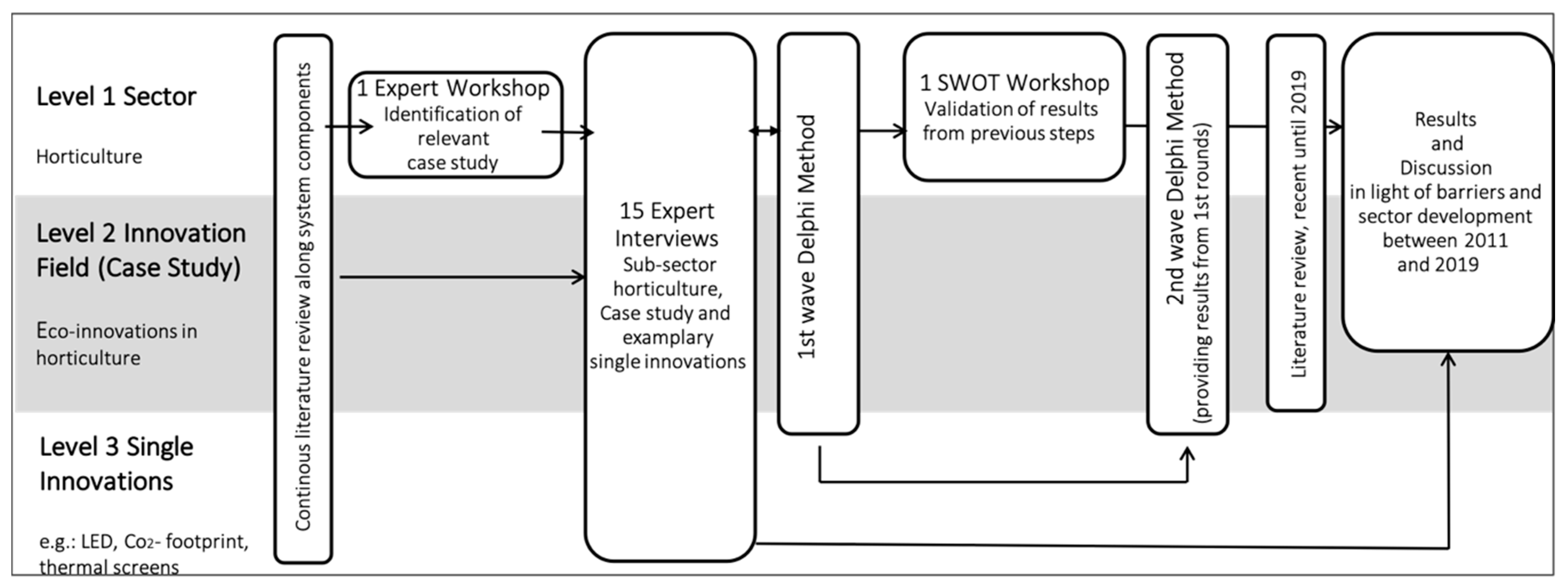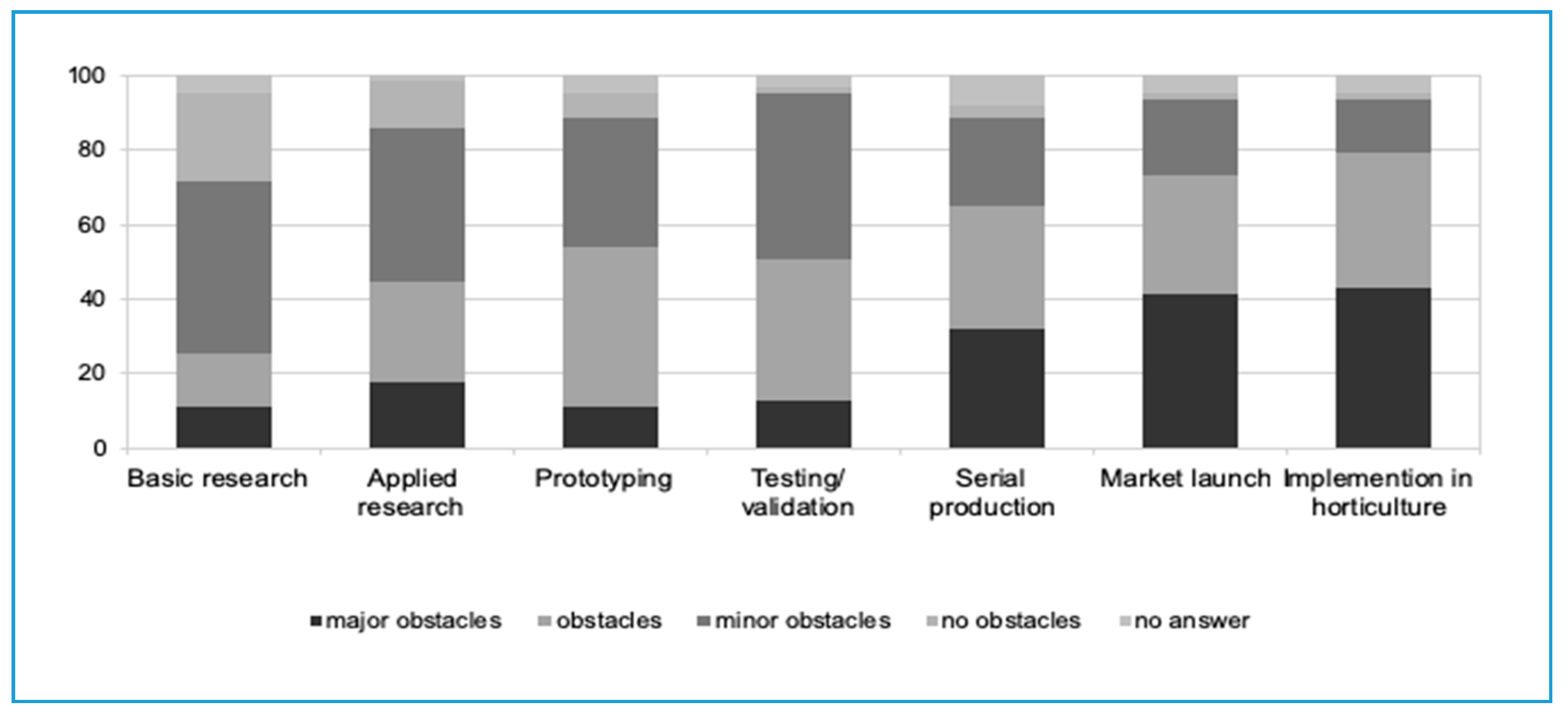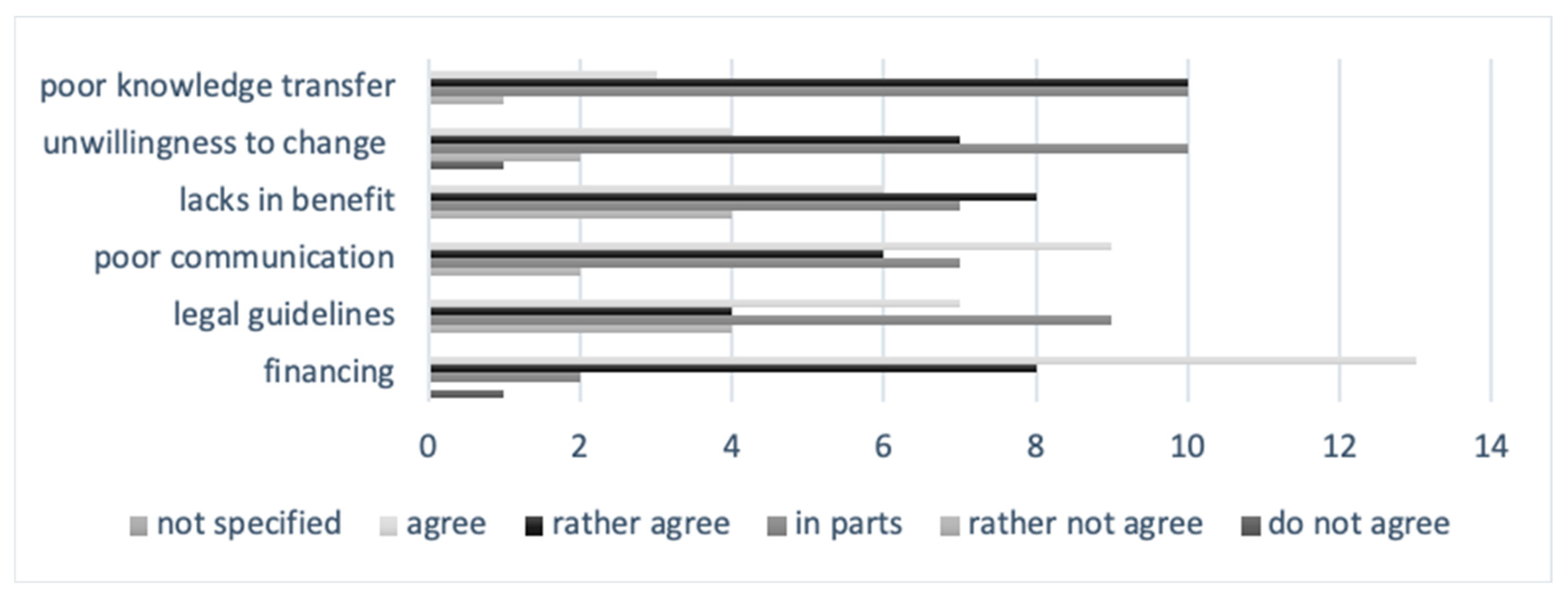Identifying System-Related Barriers for the Development and Implementation of Eco-Innovation in the German Horticultural Sector
Abstract
:1. Introduction
2. Theoretical Background
3. Materials and Methods
4. Results
4.1. Sectoral Background
4.2. Which Are Relevant ‘Technologies,’ and Are Enterprises Able to Articulate Their Demand?
4.3. What Is the Competitive Situation of Germay’s Horticultural Sector Compared to Other Regions?
4.4. Which Institutions and Politics Are in Place to Support Eco-Innovations in the Horticultural Sector?
4.5. Which Are the Central Actors and Organizations and Which Role Do They Take in the IP?
4.6. Which Role Do Intermediates Play and How Do They Interact with Others?
4.7. How Can Knowledge Help to Further Speed up Innovative Activity?
4.8. What Do This Insights Mean for Innovation Processes in the Sector?
5. Discussion and Conclusions
5.1. Discussion of Barriers
5.2. Political and Structural Barriers
5.3. Economic Barriers
5.4. Coordination/Organizational Barriers
5.5. Behavioral Barriers
Supplementary Materials
Author Contributions
Funding
Acknowledgments
Conflicts of Interest
References
- Wissenschaftlicher Beirat Agrarpolitik, Ernährung und Gesundheitlicher Verbraucherschutz und Wissenschaftlicher Beirat Waldpolitik beim BMEL. Klimaschutz in der Land-und Forstwirtschaft Sowie den Nachgelagerten Bereichen Ernährung und Holzverwendung; Gutachten: Berlin, Germany, 2016; Available online: http://www.bmel.de/SharedDocs/Downloads/Ministerium/Beiraete/Agrarpolitik/Klimaschutzgutachten_2016.pdf%3F__blob%3DpublicationFile (accessed on 14 February 2020).
- IPCC Summary for Policymakers. Climate Change and Land: An IPCC Special Report on Climate Change, Desertification, Land Degradation, Sustainable Land Management, Food Security, and Greenhouse Gas Fluxes in Terrestrial Ecosystems; Shukla, P.R., Skea, J., Calvo Buendia, E., Masson-Delmotte, V., Pörtner, H.-O., Roberts, D.C., Zhai, P., Slade, R., Connors, S., van Diemen, R., et al., Eds.; IPCC: Ginevra, Switzerland, 2019; Available online: https://www.ipcc.ch/site/assets/uploads/sites/4/2019/12/02_Summary-for-Policymakers_SPM.pdf (accessed on 14 April 2020).
- BMEL. Bundesministerium für Ernährung und Landwirtschaft. Der Gartenbau in Deutschland. Auswertung des Gartenbaumoduls der Agrarstrukturerhebung 2016. Berlin. Available online: https://www.bmel.de/SharedDocs/Downloads/Broschueren/Gartenbauerhebung.pdf?__blob=publicationFile (accessed on 20 December 2019).
- Ludolph, D. Saving Energy in German Greenhouses. Green Growing. Available online: http://www.pcsierteelt.be/hosting/pcs/pcs_site.nsf/0/FCBCFFB4EEDB8A58C1257C1A0041DBEB/$file/1-LandwirshaftskammerNiedersachsen.pdf (accessed on 15 March 2019).
- Voss, J.; Richter, B.; Theuvsen, L.; Schaper, C. Energetische Nutzung von Biomasse im Unterglas-Gartenbau. FNR Schriftenreihe Nachwachsende Rohstoffe. 2014, Band 35. Available online: https://mediathek.fnr.de/media/downloadable/files/samples/s/c/schriftenreihe_band_35_web.pdf (accessed on 14 March 2019).
- Trianni, A.; Cagno, E.; Worrell, E. Innovation and adaptation of energy efficient technologies: An exploratory analysis of Italian primary metal manufacturing SMEs. Energy Policy 2013, 61, 430–440. [Google Scholar] [CrossRef]
- Wachenfeld, A. Bundesprogramm zur Förderung von Maßnahmen zur Steigerung der Energieeffizienz in der Landwirtschaft und im Gartenbau. Bundesanstalt für Landwirtschaft und Ernährung. Forum Klimaanpassung und Klimaschutz. 2018. Available online: https://www.netzwerk-laendlicher-raum.de/fileadmin/sites/ELER/Dateien/05_Service/Veranstaltungen/2018/Klimaforum/Klimaforum_2018_Wachenfeld.pdf (accessed on 7 January 2020).
- UBA. Ökologische Innovationspolitik in Deutschland. Bestandsaufnahme und Handlungsempfehlungen. Series: Umwelt, Innovation, Beschäftigung. 2019. Available online: https://www.umweltbundesamt.de/sites/default/files/medien/1410/publikationen/2019-05-29_texte_01-2019_oekologische-innovationspolitik_v2.pdf (accessed on 7 January 2020).
- Diakosavvas, D. Improving energy efficiency in the agro-food chain. In OECD, Trade and Agriculture Directorate and Environment Directorate; Report; COM/TAD/CA/ENV/EPOC (2016)19/FINAL; 2017; Available online: http://www.oecd.org/officialdocuments/publicdisplaydocumentpdf/?cote=COM/TAD/CA/ENV/EPOC(2016)19/FINAL&docLanguage=En (accessed on 28 May 2020).
- Jänicke, M. Megatrend Umweltinnovation: Zur ökologischen Modernisierung von Wirtschaft und Staat; Oekom: München, Germany, 2018; ISBN 978-3-86581-097-7. [Google Scholar]
- Lidskog, R.; Elander, I. Ecological Modernization in Practice? The Case of Sustainable Development in Sweden. J. Environ. Policy Plan. 2012, 14, 411–427. [Google Scholar] [CrossRef]
- Chai, K.-H.; Yeo, C. Overcoming energy-efficiency barriers through systems approach—A conceptual framework. Energy Policy 2012, 46, 460–472. [Google Scholar] [CrossRef]
- Gicon. Energieeffizienz im Gartenbau. Ergebnisse aus dem Sächsischen Wissenstransferproject 2017/18. 2018. Available online: www.gicon.de (accessed on 15 October 2019).
- Klewitz, J.; Hansen, E.G. Sustainability-oriented innovation of SMEs: A systematic review. J. Clean. Prod. 2014, 65, 57–75. [Google Scholar] [CrossRef]
- Soode, E.; Lampert, P.; Weber-Blaschke, G.; Richter, K. Carbon Footprints of the horticultural products strawberries, asparagus, roses and orchids in Germany. J. Clean. Prod. 2014, 87, 1–12. [Google Scholar] [CrossRef]
- BMEL (Ed.) Zukunftsstrategie Gartenbau: Abschlussbericht zum Zukunftskongress Gartenbau. 2013. Available online: https://www.bmel.de/SharedDocs/Downloads/Broschueren/ZukunftsstrategieGartenbau.pdf?__blob=publicationFile (accessed on 7 January 2020).
- BMEL (Ed.) Der Gartenbau in Deutschland, Daten und Fakten; Bundesministerium für Landwirtschaft und Ernährung: Bonn, Germany, 2014; Available online: https://www.bmel.de/SharedDocs/Downloads/Broschueren/Der-Gartenbau-in-Deutschland.html (accessed on 10 October 2019).
- BMEL (Ed.) Daten und Fakten, Land-, Forst und Ernährungswirtschaft mit Fischerei und Wein- und Gartenbau; Broschüre des Bundesministeriums für Ernährung und Landwirtschaft: Berlin, Germany, 2017; Available online: Bmel.de/publikationen (accessed on 10 October 2019).
- Bisbis, M.B.; Gruda, N.S.; Blanke, M.M. Securing Horticulture in a changing climate—A mini review. Horticulturae 2019, 5, 65. [Google Scholar] [CrossRef] [Green Version]
- Fresner, J.; Morea, F.; Krenn, C.; Uson, J.A.; Tomasi, F. Energy efficiency in small and medium sized enterprises: Lessons learned from 280 energy audits across Europe. J. Clean. Prod. 2017, 142, 1650–1660. [Google Scholar] [CrossRef]
- McIntyre, B.D.; Herren, H.R.; Wakhungu, J.; Watson, R.T. (Eds.) Synthesis Report with Executive Summary: A Synthesis of the Global and Sub-Global IAASTD Reports; International Assessment of Agricultural Knowledge, Science and Technology for Development (IAASTD): Washington, DC, USA, 2009; Available online: https://www.weltagrarbericht.de/fileadmin/files/weltagrarbericht/IAASTDBerichte/GlobalReport.pdf (accessed on 10 October 2019).
- Dirksmeyer, W. (Ed.) Status quo und Perspektiven des Deutschen Produktionsgartenbaus; Sonderheft 330; von Thünen Institut (vTI) Landbauforschung: Braunschweig, Germany, 2009; pp. 131–136. [Google Scholar]
- Knopf, J.; Mundt, I.; Kirchner, R.; Kahlenborn, W.; Blazejcak, J.; Edler, D.; Schill, W.-P.; Sartorius, C.; Walz, R. Ökologische Modernisierung der Wirtschaft durch eine Moderne Umweltpolitik. Synthesebericht. Umwelt, Innovation, Beschäftigung, 02/2016. Umweltforschungsplan des Bundesministeriums für Umwelt, Naturschutz, Bau und Reaktorsicherheit. 2016. Available online: https://www.umweltbundesamt.de/sites/default/files/medien/378/publikationen/uib_02_2016_oekologische_modernisierung_der_wirtschaft_durch_eine_moderne_umweltpolitik_0.pdf (accessed on 7 January 2020).
- Fleiter, T.; Schleich, J.; Ravivanpong, P. Adoption of energy-efficiency measures in SMEs—An empirical analysis based on energy audit data from Germany. Energy Policy 2012, 51, 863–875. [Google Scholar] [CrossRef]
- Bocken, N.M.P.; Farracho, M.; Bosworth, R.; Kemp, R. The front-end of eco-innovation for eco-innovative small and medium sized companies. J. Eng. Technol. Manag. 2014, 3, 43–57. [Google Scholar] [CrossRef] [Green Version]
- Aramyan, L.H.; Oude Lansink, A.G.J.M.; Verstegen, J.A.A.M. Factors underlying the investment decision in energy-saving systems in Dutch horticulture. Agric. Syst. 2007, 94, 520–527. [Google Scholar] [CrossRef]
- De Groot, H.L.F.; Verhoef, E.T.; Nijkamp, P. Energy-saving by firms: Decision-making, barriers and policies. Energy Econ. 2001, 23, 717–740. [Google Scholar] [CrossRef] [Green Version]
- Backlund, S.; Thollander, P.; Ottoson, M.; Palm, J. Extending the Energy Efficiency Gap. Energy Policy 2012, 51, 392–396. [Google Scholar] [CrossRef] [Green Version]
- Sorrell, S.; O’Malley, E.; Schleich, J.; Scott, S. The Economics of Energy Efficiency Barriers to Cost-Effective Investment; Edward Elgar Publishing Limited: Cheltenham, UK, 2012. [Google Scholar]
- Spielmann, D.J.; Birner, R. How Innovative Is Your Agriculture?: Using Innovation Indicators and Benchmarks to Strengthen National Agricultural Innovation Systems; Agricultural and Rural Development Discussion Papers; World Bank: New York, NY, USA, 2008; Available online: http://siteresources.worldbank.org/INTARD/Resources/InnovationIndicatorsWeb.pdf (accessed on 10 October 2019).
- Koschatzky, K.; Baier, E.; Kroll, H.; Stahlecker, T. The Spatial Multidimensionality of Sectoral Innovation: The Case of Information and Communication Technologies; Working Papers Firms and Region; Fraunhofer ISI: Karlsruhe, Germany, 2009; pp. 897–920. Available online: https://www.isi.fraunhofer.de/content/dam/isi/dokumente/ccp/unternehmen-region/2009/ap_r4_2009.pdf (accessed on 10 October 2019).
- Menrad, K.; Gabriel, A. National Innovation Systems in Horticulture in Germany and the Netherlands. In Proceedings of the Fifth International Symposium on Management of Technology (ISMOT), Hangzhou, China, 1–3 June 2007; Available online: https://forschung.hswt.de/web/veroeffentlichungen/person/52.pdf?wurdegesucht=true (accessed on 28 May 2020).
- Bokelmann, W.; Doernberg, A.; Schwerdtner, W.; Kuntosch, A.; Busse, M.; König, B.; Siebert, R.; Koschatzky, K.; Stahlecker, T. Sektorstudie zur Untersuchung des Innovationssystems der Deutschen Landwirtschaft; Project Report; Open Access Server—Humboldt Universität zu Berlin: Berlin, Germany, 2012. [Google Scholar] [CrossRef]
- Bantis, F.; Smirnarku, S.; Ouzounis, T.; Koukounaras, A.; Mtagkas, N.; Kalliopi, R. Current status and recent achievements in the field of horticulture with the use of light-emitting diodes (LED). Sci. Hortic. 2018, 235, 437–451. [Google Scholar] [CrossRef]
- Sächsische Landesanstalt für Landwirtschaft (Ed.) Energiekonzepte für den Gartenbau. Untersuchungen zu den Auswirkungen weiterer Heizölpreissteigerungen auf sächsische Gartenbauunternehmen, daraus abgeleitete innovative Handlungsfelder und Strategien. Schriftenreihe der Sächsischen Landesanstalt für Landwirtschaft; Heft 20; Sächsische Landesanstalt für Landwirtschaft: Dresden, Germany, 2009; Available online: https://www.researchgate.net/publication/44229525_Energiekonzepte_fur_den_Gartenbau_-_Untersuchungen_zu_den_Auswirkungen_weiterer_Heizolpreissteigerungen_auf_sachsische_Gartenbauunternehmen_daraus_abgeleitete_innovative_Handlungsfelder_und_Strategien (accessed on 10 October 2019).
- Kuratorium für Technik und Bauwesen in der Landwirtschaft (KTBL) (Ed.) Energie macht Zukunft. Konzepte für den Optimierten Energieeinsatz im Gartenbau; Sonderheft zur IPM Messe Essen: Darmstadt, Germany, 2011; Available online: https://www.dega-gartenbau.de/Aktuelles/IPM-2011-Energie-macht-Zukunft-Lehrschau-des-Infocenters-Gartenbau,QUlEPTE5ODMyNjQmTUlEPTUxODQ1.html (accessed on 10 October 2019).
- Hertel, M.; Menrad, K. Adoption of energy-efficient technologies in German SMEs of the horticultural sector—The moderating role of personal and social factors. Energy Effic. 2016, 9, 791–806. [Google Scholar] [CrossRef]
- Vereijssen, J.; Srinivasan, M.; Dirks, S.; Fielke, S.; Jongmans, C.; Agnew, N.; Klerkx, L.; Pinxterhuis, I.; Moore, J.; Edwards, P.; et al. Addressing complex challenges using a co-innovation approach: Lessons from five case studies in the New Zealand primary sector. Outlook Agric. 2017, 44, 108–116. [Google Scholar] [CrossRef]
- Hekkert, M.P.; Suurs, R.A.A.; Negro, S.O.; Kuhlmann, S.; Smits, R.E.H.M. Functions of innovation systems: A new approach for analysing technological change. Technol. Forecast. Soc. Chang. 2007, 74, 413–432. [Google Scholar] [CrossRef] [Green Version]
- Malerba, F. (Ed.) Sectoral Systems of Innovation: Concepts, Issues and Analysis of Six Major Sectors in Europe; Cambridge University Press: Cambridge, UK, 2004; Available online: https://assets.cambridge.org/97805218/33219/frontmatter/9780521833219_frontmatter.pdf (accessed on 10 October 2019).
- Malerba, F. Sectoral Systems of innovation and production. Res. Policy 2002, 31, 247–263. [Google Scholar] [CrossRef]
- Carlsson, B.; Jacobsson, S.; Holmen, M.; Rickne, A. Innovation systems: Analytical and methodological issues. Res. Policy 2002, 31, 233–245. [Google Scholar] [CrossRef]
- Beise, M.; Rennings, K. Lead Markets of Environmental Innovations: A Framework for Innovation and Environmental Economics; ZEW Discussion Papers No.03-01; Mannheim, Germany, 2001; Available online: http://ftp.zew.de/pub/zew-docs/dp/dp0301.pdf (accessed on 7 January 2020).
- Van Latesteijn, H.C.; Andeweg, K. The need for a new agro innovation system. In The Transforum Model: Transforming Agro Innovation toward Sustainable Development; Latesteijn, H.-C., Andeweg, K., Eds.; Springer: Dordrecht, The Netherlands, 2011; pp. 1–27. [Google Scholar] [CrossRef]
- Schot, J.; Steinmueller, W.E. Three frames for innovation policy: R&D, systems of innovation and transformative change. Res. Policy 2018, 47, 1554–1567. [Google Scholar] [CrossRef]
- Weber, K.M.; Rohracher, H. Legitimizing research, technology and innovation policies for transformative change. Combining insights from innovation systems and multi-level perspective in a comprehensive ‘failures’ framework. Res. Policy 2012, 41, 1037–1047. [Google Scholar] [CrossRef]
- Bokelmann, W. Wertschöpfungsketten im Gartenbau; Dirksmeyer, W., Ed.; Sonderheft 330; von Thünen Institut (vTI) Landbauforschung: Braunschweig, Germany, 2009; pp. 15–129. Available online: https://literatur.thuenen.de/digbib_extern/bitv/dk042505.pdf (accessed on 10 October 2019).
- Klerkx, L.; van Mierlo, B.; Leeuwis, C. Evolution of systems approaches to agricultural innovation: Concepts, analysis and interventions. In Farming Systems Research into the 21th Century: The New Dynamic; Darnhofer, I., Gibbon, D., Dedieu, B., Eds.; Springer: Berlin, Germany, 2012. [Google Scholar] [CrossRef]
- Elzen, B.; Geels, F.W.; Green, K. System Innovation and the Transition to Sustainability: Theory, Evidence and Policy; Edward Elgar: Cheltham, UK; Northampton, MA, USA, 2004; ISBN 1-84376-683-3. [Google Scholar]
- Siebenhühner, B. Methoden und Methodenprobleme in der Innovationsforschung. In Innovationsforschung, Ansätze, Methoden, Grenzen und Perspektiven; Hof, H., Wengenroth, U., Eds.; LIT Verlag: Münster, Germany, 2010. [Google Scholar]
- Wittmayer, J.; Pel, B.; Bauler, T.; Avelino, F. Editorial Synthesis: Methodological Challenges in Social Innovation Research. Eur. Public Soc. Innov. Rev. 2017, 2. [Google Scholar] [CrossRef] [Green Version]
- Bergek, A.; Jacobsson, S.; Carlsson, B.; Lindmark, S.; Rickne, A. Analyzing the functional dynamics of technologofical innovation systems: A scheme of analysis. Res. Policy 2008, 37, 407–429. [Google Scholar] [CrossRef] [Green Version]
- Yin, R.K. Case Study Research: Design and Methods, 4th ed.; Sage Publications: London, UK, 2009. [Google Scholar]
- Goffin, K.; Ahlstom, P.; Bianchi, M.; Richtnér, A. State-if-the-Art: The quality of case study research in innovation management. J. Prod. Innov. Manag. 2019, 36, 586–615. [Google Scholar] [CrossRef] [Green Version]
- Busse, M.; Doernberg, A.; Siebert, R.; Kuntosch, A.; Schwerdtner, W.; König, B.; Bokelmann, W. Innovation mechanisms in German precision farming. Precis. Agric. 2014, 4, 403–426. [Google Scholar] [CrossRef]
- König, B.; Kuntosch, A.; Bokelmann, W.; Doernberg, A.; Siebert, R.; Busse, M.; Schwerdtner, W.; Koschatzky, K.; Stahlecker, T. Nachhaltige Innovationen in der Landwirtschaft: Komplexe Herausforderungen im Innovationssystem. DIW Vierteljahresh. Wirtsch. 2012, 81, 71–91. [Google Scholar] [CrossRef] [Green Version]
- Meuser, M.; Nagel, U.-J. ExpertInneninterviews—Viel erprobt, wenig bedacht. Ein Beitrag zur qualitativen Methodendiskussion. In Das Experteninterview: Theorie, Methode, Anwendung; Bogner, A., Littig, B., Menz, W., Eds.; Westdeutscher Verlag: Opladen, Germany, 2002; pp. 71–93. [Google Scholar]
- Kuckartz, U. Mixed Methods, Methodologies, Forschungsdesigns und Analyseverfahren; Springer: Wiesbaden, Germany, 2014. [Google Scholar] [CrossRef]
- Gibbs, G.R. Analysing Qualitative Data; The SAGE Qualitative Research Kit; Sage Publications: London, UK, 2009. [Google Scholar]
- Kvale, S. Doing Interviews; The SAGE Qualitative Research Kit; Sage Publications: London, UK, 2007. [Google Scholar]
- Beckenbach, F. Akteurbefragung als Grundlage für die Erfassung von Innovationsprozessen—Möglichkeiten und Grenzen. In Innovationsforschung Band 1: Ansätze, Methoden, Grenzen und Perspektiven; LIT Verlag: Münster, Germany, 2007. [Google Scholar]
- O’Connor, C.; Joffe, H. Intercoder Reliability in Qualitative Research: Debates and Practical Guidelines. Int. J. Qual. Methods 2020, 19, 1–13. [Google Scholar] [CrossRef]
- Busse, M.; Schwerdtner, W.; Siebert, R.; Doernberg, A.; Kuntosch, A.; König, B.; Bokelmann, W. Anaysis of animal monitoring technologies in Germany from an innovation systems perspective. Agric. Syst. 2015, 138, 55–65. [Google Scholar] [CrossRef]
- Häder, M. Delphi-Befragungen: Ein Arbeitsbuch; VS Verlag für Sozialwissenschaften: Wiesbaden, Germany, 2002. [Google Scholar]
- Geist, M.R. Using the Delphi method to engage stakeholders: A comparison of two studies. Eval. Program Plan. 2010, 33, 147–154. [Google Scholar] [CrossRef]
- Geisler, E. Intersector technology cooperation: Hard myths, soft facts. Technovation 1997, 17, 309–320. [Google Scholar] [CrossRef]
- Ammon, U. Delphi-Befragung. In Quantitative Methoden der Organisationsforschung; Kühl, S., Strodtholz, P., Taffertshofer, A., Eds.; Verlag für Sozialwissenschaften: Wiesbaden, Germany, 2005; pp. 458–476. [Google Scholar]
- Montero, J.I.; Antón, A.; Rorellas, M.; Ruijs, M.; Vermaulen, P. Environmental and Economic Profile of Present Greenhouse Production Systems in Europe; Project Report EUPHOROS Deliverable No. 5; European Commission: Brussels, Belgium, 2011; Available online: https://edepot.wur.nl/222832 (accessed on 4 January 2020).
- Energieargentur NRW. Information Energieeffizienz im Gartenbau. Available online: https://www.energieagentur.nrw/energieeffizienz/energieeffizienz-nach-branchen/energieeffizienz_im_gartenbau. (accessed on 6 January 2020).
- Mayerding, S. Die Energieeffizienzlücke-warum ‘‘effiziente’’ Maßnahmen nicht umgesetzt werden. Ber. Landwirtsch. 2016, 94, 1. [Google Scholar]
- Schleich, J. Barriers to energy efficiency: A comparison across the German commercial and serv ice sector. Energy Econ. 2009, 68, 2150–2159. [Google Scholar] [CrossRef]
- Knickel, K.; Brunori, G.; Rand, S.; Proost, J. Towards a better conceptual framework for innovation processes in agriculture and rural development: From linear models to systemic approaches. In Proceedings of the 8th European IFSA Symposium, Clermont-Ferrand, France, 6–10 July 2008; Available online: http://ifsa.boku.ac.at/cms/fileadmin/Proceeding2008/2008_WS6_10_Knickel.pdf (accessed on 10 October 2019).
- Klerkx, L.; Leeuwis, C. Balancing multiple interests: Embedding innovation intermediation in the agricultural knowledge infrastructure. Technovation 2008, 28, 364–378. [Google Scholar] [CrossRef]
- Ingram, J.; Morris, C. The knowledge challenge within the transition towards sustainable soil management: An Analysis of agricultural advisors in England. Land Use Policy 2007, 24, 100–117. [Google Scholar] [CrossRef]
- Hurmelinna-Laukkanen, P.; Nätti, S. Orchestrator types, roles and capabilities—A framework for innovation networks. Ind. Mark. Manag. 2018, 74, 65–78. [Google Scholar] [CrossRef]
- Fagerberg, J. Innovation: A guide to the literature. Presented at the Workshop: “The Many Guises of Innovation: What Have We Learnt and Where Are We Heading”, Ottawa, ON, Canada, 23–24 October 2003; Available online: http://folk.uio.no/janf/downloadable_papers/03fagerberg_innovation_ottawa.pdf (accessed on 10 September 2019).
- BMWI NAPE. Available online: https://www.bmwi.de/Redaktion/DE/Artikel/Energie/nape-mehr-aus-energie-machen.html (accessed on 18 December 2019).



| Expert Groups | Interviews per Group | Core Competences of Experts per Group |
|---|---|---|
| Intermediate organizations and politics | 4 | General political frameworks related to eco-innovations, coordination and networking across institutions |
| Horticultural enterprises/practitioners | 3 | Exemplary innovation: breeding, LED lighting, thermal screens, practice-science cooperation |
| Supplier industries | 2 | Building cross-sectoral networks |
| University and non-university research institutions | 3 | Characteristics of IPs in the sector, mechanisms in science-practice collaboration |
| Labeling and certification | 1 | Labeling (e.g., CO2) in Germany compared with other countries |
| Extension services and energy contracting | 2 | Role of extension in horticulture, networking and pooling of energy. |
| Groups of Experts Invited for Delphi 1 and 2 | Number of Experts per Group |
|---|---|
| Production (organic and conventional) | 7 |
| Supplier industries (incl. public services, excluding extension) | 9 |
| Services (e.g., financing) | 3 |
| Extension services | 6 |
| Science | 11 |
| Intermediate organizations (media, associations organic and conventional) | 9 |
| Political institutions and administration | 1 |
| Others (e.g., retail, marketing, cooperatives) | 3 |
| Producer organizations | 2 |
| Total | 51 |
© 2020 by the authors. Licensee MDPI, Basel, Switzerland. This article is an open access article distributed under the terms and conditions of the Creative Commons Attribution (CC BY) license (http://creativecommons.org/licenses/by/4.0/).
Share and Cite
Kuntosch, A.; König, B.; Bokelmann, W.; Doernberg, A.; Siebert, R.; Schwerdtner, W.; Busse, M. Identifying System-Related Barriers for the Development and Implementation of Eco-Innovation in the German Horticultural Sector. Horticulturae 2020, 6, 33. https://doi.org/10.3390/horticulturae6020033
Kuntosch A, König B, Bokelmann W, Doernberg A, Siebert R, Schwerdtner W, Busse M. Identifying System-Related Barriers for the Development and Implementation of Eco-Innovation in the German Horticultural Sector. Horticulturae. 2020; 6(2):33. https://doi.org/10.3390/horticulturae6020033
Chicago/Turabian StyleKuntosch, Anett, Bettina König, Wolfgang Bokelmann, Alexandra Doernberg, Rosemarie Siebert, Wim Schwerdtner, and Maria Busse. 2020. "Identifying System-Related Barriers for the Development and Implementation of Eco-Innovation in the German Horticultural Sector" Horticulturae 6, no. 2: 33. https://doi.org/10.3390/horticulturae6020033
APA StyleKuntosch, A., König, B., Bokelmann, W., Doernberg, A., Siebert, R., Schwerdtner, W., & Busse, M. (2020). Identifying System-Related Barriers for the Development and Implementation of Eco-Innovation in the German Horticultural Sector. Horticulturae, 6(2), 33. https://doi.org/10.3390/horticulturae6020033




